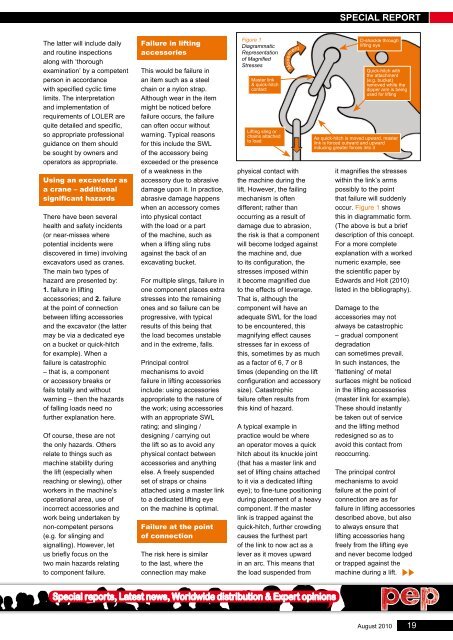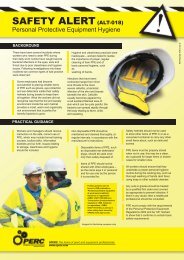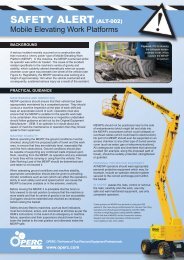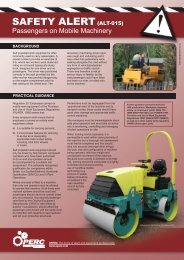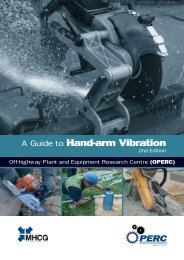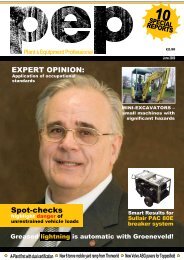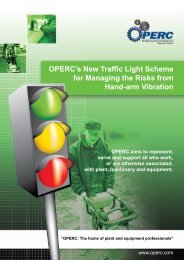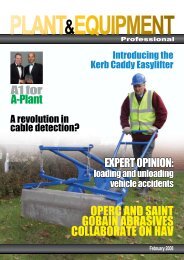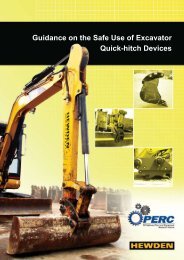the PeoPle - OPERC - Off-highway Plant and Equipment Research ...
the PeoPle - OPERC - Off-highway Plant and Equipment Research ...
the PeoPle - OPERC - Off-highway Plant and Equipment Research ...
You also want an ePaper? Increase the reach of your titles
YUMPU automatically turns print PDFs into web optimized ePapers that Google loves.
The latter will include daily<br />
<strong>and</strong> routine inspections<br />
along with ‘thorough<br />
examination’ by a competent<br />
person in accordance<br />
with specified cyclic time<br />
limits. The interpretation<br />
<strong>and</strong> implementation of<br />
requirements of LOLER are<br />
quite detailed <strong>and</strong> specific,<br />
so appropriate professional<br />
guidance on <strong>the</strong>m should<br />
be sought by owners <strong>and</strong><br />
operators as appropriate.<br />
using an excavator as<br />
a crane – additional<br />
significant hazards<br />
There have been several<br />
health <strong>and</strong> safety incidents<br />
(or near-misses where<br />
potential incidents were<br />
discovered in time) involving<br />
excavators used as cranes.<br />
The main two types of<br />
hazard are presented by:<br />
1. failure in lifting<br />
accessories; <strong>and</strong> 2. failure<br />
at <strong>the</strong> point of connection<br />
between lifting accessories<br />
<strong>and</strong> <strong>the</strong> excavator (<strong>the</strong> latter<br />
may be via a dedicated eye<br />
on a bucket or quick-hitch<br />
for example). When a<br />
failure is catastrophic<br />
– that is, a component<br />
or accessory breaks or<br />
fails totally <strong>and</strong> without<br />
warning – <strong>the</strong>n <strong>the</strong> hazards<br />
of falling loads need no<br />
fur<strong>the</strong>r explanation here.<br />
Of course, <strong>the</strong>se are not<br />
<strong>the</strong> only hazards. O<strong>the</strong>rs<br />
relate to things such as<br />
machine stability during<br />
<strong>the</strong> lift (especially when<br />
reaching or slewing), o<strong>the</strong>r<br />
workers in <strong>the</strong> machine’s<br />
operational area, use of<br />
incorrect accessories <strong>and</strong><br />
work being undertaken by<br />
non-competent persons<br />
(e.g. for slinging <strong>and</strong><br />
signalling). However, let<br />
us briefly focus on <strong>the</strong><br />
two main hazards relating<br />
to component failure.<br />
failure in lifting<br />
accessories<br />
This would be failure in<br />
an item such as a steel<br />
chain or a nylon strap.<br />
Although wear in <strong>the</strong> item<br />
might be noticed before<br />
failure occurs, <strong>the</strong> failure<br />
can often occur without<br />
warning. Typical reasons<br />
for this include <strong>the</strong> SWL<br />
of <strong>the</strong> accessory being<br />
exceeded or <strong>the</strong> presence<br />
of a weakness in <strong>the</strong><br />
accessory due to abrasive<br />
damage upon it. In practice,<br />
abrasive damage happens<br />
when an accessory comes<br />
into physical contact<br />
with <strong>the</strong> load or a part<br />
of <strong>the</strong> machine, such as<br />
when a lifting sling rubs<br />
against <strong>the</strong> back of an<br />
excavating bucket.<br />
For multiple slings, failure in<br />
one component places extra<br />
stresses into <strong>the</strong> remaining<br />
ones <strong>and</strong> so failure can be<br />
progressive, with typical<br />
results of this being that<br />
<strong>the</strong> load becomes unstable<br />
<strong>and</strong> in <strong>the</strong> extreme, falls.<br />
Principal control<br />
mechanisms to avoid<br />
failure in lifting accessories<br />
include: using accessories<br />
appropriate to <strong>the</strong> nature of<br />
<strong>the</strong> work; using accessories<br />
with an appropriate SWL<br />
rating; <strong>and</strong> slinging /<br />
designing / carrying out<br />
<strong>the</strong> lift so as to avoid any<br />
physical contact between<br />
accessories <strong>and</strong> anything<br />
else. A freely suspended<br />
set of straps or chains<br />
attached using a master link<br />
to a dedicated lifting eye<br />
on <strong>the</strong> machine is optimal.<br />
failure at <strong>the</strong> point<br />
of connection<br />
The risk here is similar<br />
to <strong>the</strong> last, where <strong>the</strong><br />
connection may make<br />
Figure 1<br />
Diagrammatic<br />
Representation<br />
of Magnified<br />
Stresses<br />
Master link<br />
& quick-hitch<br />
contact<br />
Lifting sling or<br />
chains attached<br />
to load<br />
physical contact with<br />
<strong>the</strong> machine during <strong>the</strong><br />
lift. However, <strong>the</strong> failing<br />
mechanism is often<br />
different; ra<strong>the</strong>r than<br />
occurring as a result of<br />
damage due to abrasion,<br />
<strong>the</strong> risk is that a component<br />
will become lodged against<br />
<strong>the</strong> machine <strong>and</strong>, due<br />
to its configuration, <strong>the</strong><br />
stresses imposed within<br />
it become magnified due<br />
to <strong>the</strong> effects of leverage.<br />
That is, although <strong>the</strong><br />
component will have an<br />
adequate SWL for <strong>the</strong> load<br />
to be encountered, this<br />
magnifying effect causes<br />
stresses far in excess of<br />
this, sometimes by as much<br />
as a factor of 6, 7 or 8<br />
times (depending on <strong>the</strong> lift<br />
configuration <strong>and</strong> accessory<br />
size). Catastrophic<br />
failure often results from<br />
this kind of hazard.<br />
A typical example in<br />
practice would be where<br />
an operator moves a quick<br />
hitch about its knuckle joint<br />
(that has a master link <strong>and</strong><br />
set of lifting chains attached<br />
to it via a dedicated lifting<br />
eye); to fine-tune positioning<br />
during placement of a heavy<br />
component. If <strong>the</strong> master<br />
link is trapped against <strong>the</strong><br />
quick-hitch, fur<strong>the</strong>r crowding<br />
causes <strong>the</strong> fur<strong>the</strong>st part<br />
of <strong>the</strong> link to now act as a<br />
lever as it moves upward<br />
in an arc. This means that<br />
<strong>the</strong> load suspended from<br />
Special reports, Latest news, Worldwide distribution & Expert opinions<br />
Movement<br />
SPECIAL REPORT<br />
D-shackle through<br />
lifting eye<br />
Quick-hitch with<br />
<strong>the</strong> attachment<br />
(e.g. bucket)<br />
removed while <strong>the</strong><br />
dipper arm is being<br />
used for lifting<br />
As quick-hitch is moved upward, master<br />
link is forced outward <strong>and</strong> upward<br />
inducing greater forces into it<br />
it magnifies <strong>the</strong> stresses<br />
within <strong>the</strong> link’s arms<br />
possibly to <strong>the</strong> point<br />
that failure will suddenly<br />
occur. Figure 1 shows<br />
this in diagrammatic form.<br />
(The above is but a brief<br />
description of this concept.<br />
For a more complete<br />
explanation with a worked<br />
numeric example, see<br />
<strong>the</strong> scientific paper by<br />
Edwards <strong>and</strong> Holt (2010)<br />
listed in <strong>the</strong> bibliography).<br />
Damage to <strong>the</strong><br />
accessories may not<br />
always be catastrophic<br />
– gradual component<br />
degradation<br />
can sometimes prevail.<br />
In such instances, <strong>the</strong><br />
‘flattening’ of metal<br />
surfaces might be noticed<br />
in <strong>the</strong> lifting accessories<br />
(master link for example).<br />
These should instantly<br />
be taken out of service<br />
<strong>and</strong> <strong>the</strong> lifting method<br />
redesigned so as to<br />
avoid this contact from<br />
reoccurring.<br />
The principal control<br />
mechanisms to avoid<br />
failure at <strong>the</strong> point of<br />
connection are as for<br />
failure in lifting accessories<br />
described above, but also<br />
to always ensure that<br />
lifting accessories hang<br />
freely from <strong>the</strong> lifting eye<br />
<strong>and</strong> never become lodged<br />
or trapped against <strong>the</strong><br />
machine during a lift.<br />
August 2010<br />
19


